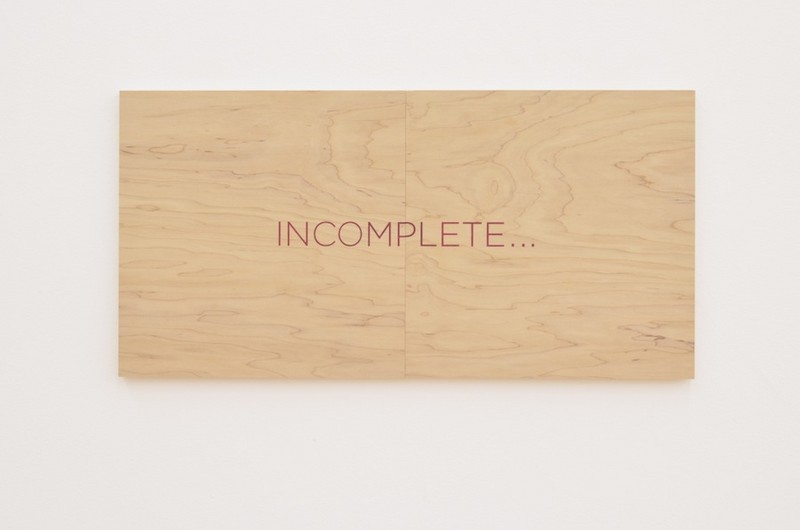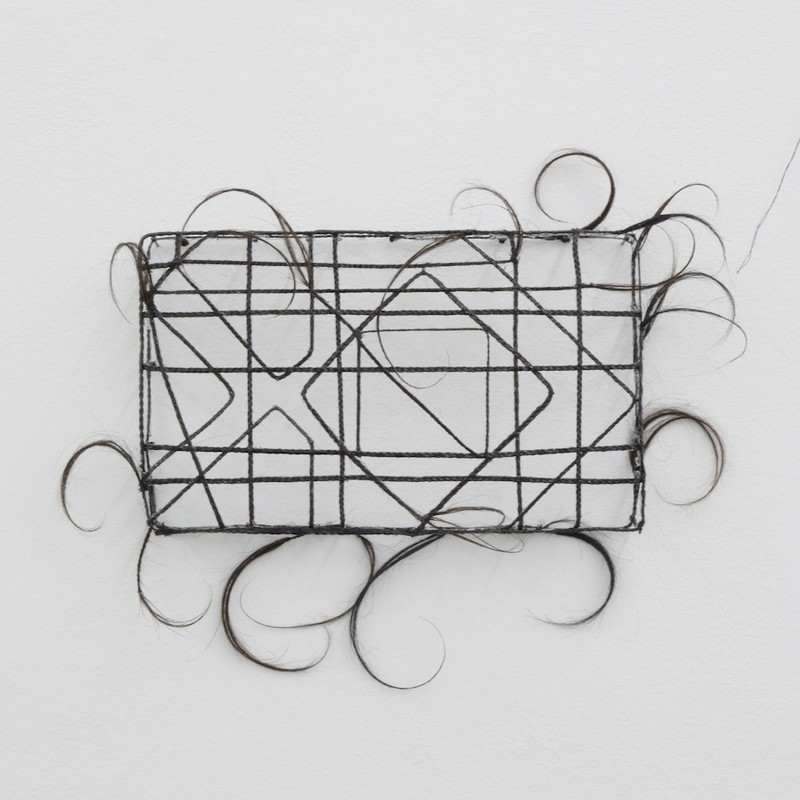Robert Barry, Hoda Tawakol
06 Sep - 01 Nov 2014
ROBERT BARRY, HODA TAWAKOL
6 September - 1 November 2014
Robert Barry
new work
A major protagonist and pioneer of Conceptual Art, Robert Barry has been making language-based artwork since the sixties. By arranging words in lists, circles, or scattered compositions on paper, canvases, mirrors, videos, walls, windows, floors and buildings, Barry’s work has explored meaning and its various modes of communication and display. By selecting a potent set of single words, the artist provides viewers with suggestions and possibilities for the relationships between words themselves, between words and images (and words as images), and between words and viewers.
For this show at Sfeir-Semler, Hamburg, Barry is showing only new work: large paintings on canvas as well as works on paper and on wood continuing Barry’s investigation into the rich, wordless possibilities of color paired with direct but various significations of language.
With solo shows in major venues around the world, Robert Barry has established himself as one of the foremost artists in the continuing history of Conceptual Art since 1960s. His work has been included in many major public and museum shows and collections such as Documenta 5, 6, 7, Moma New York and Los Angeles, the Museum of Modern Art in Frankfurt, the Stedelijk Museum in Amsterdam, PS1 in New York, Kunstmuseum Luzern, Switzerland and many others. Born in New York in 1936, he lives and works in Teaneck, New Jersey.
Hoda Tawakol
Incommunicado
Incommunicado refers to a situation or a behavior whereby communication with outsiders is not possible for either voluntary or involuntary reasons, but especially due to confinement or reclusiveness. In her upcoming show at Galerie Sfeir-Semler, Hoda Tawakol explores the situation of women and culture in conventional Egypt and how society has placed them in an “incommunicado”- like environment. Her works show a deconstructed and abstracted version of ways of concealing the female body and sexuality. Her sculptures with hair imitate the structure of traditional Egyptian hijab, yet instead of hiding a women’s hair, Tawakol exposes them and defeats the purpose of the hijab. What should be hidden (the hair) becomes a mask or a veil itself. What remains behind the mask is simply the empty volume of a person, and the woman imagined underneath disappears.
Just as the hijab is a form of imposed suppression by a controlling patriarchal society, Tawakol also explores the tradition of falconry keeping. A sport that is still common in the Middle East, uses custom-made helmets to shield the predator bird’s sight in order to remove the animal from the world. Enlarged to fit a human’s head, it questions the interaction between the hunter and the prey, between the viewer and the contemplated object, and between desire and control. Now made of transparent fabric in the new series, the falconry hood transforms into an ambivalent object.
Tawakol’s Egyptian roots are integral to her work with arabesque patterns and Middle Eastern traditions. The show will also include series of works based on textile and architectural motifs to further illustrate Tawakol’s concept of interrupted communication. A single shape is isolated and taken out of its usual context and put back into a bigger shape, or an ornament, where it vanishes as a single unit. The veil or the Egyptian mashrabiya, which is meant to hide women from the external world, is also isolating them and letting them vanish. The artist embroiders these patterns on delicate material with razor sharp metal ornaments. The metal applications, which resemble the shape of the wood structure within the mashrabiyas, have actually been extracted from the centre of a razor blade. The metal application represents what has been removed and what is now of no use, a waste, metaphorically representing female circumcision and loss of virginity.
Born in London in 1968 and raised primarily in Paris, Hoda Tawakol studied in the class of Andreas Slominski at the Hochschule für Bildende Künste in Hamburg.
6 September - 1 November 2014
Robert Barry
new work
A major protagonist and pioneer of Conceptual Art, Robert Barry has been making language-based artwork since the sixties. By arranging words in lists, circles, or scattered compositions on paper, canvases, mirrors, videos, walls, windows, floors and buildings, Barry’s work has explored meaning and its various modes of communication and display. By selecting a potent set of single words, the artist provides viewers with suggestions and possibilities for the relationships between words themselves, between words and images (and words as images), and between words and viewers.
For this show at Sfeir-Semler, Hamburg, Barry is showing only new work: large paintings on canvas as well as works on paper and on wood continuing Barry’s investigation into the rich, wordless possibilities of color paired with direct but various significations of language.
With solo shows in major venues around the world, Robert Barry has established himself as one of the foremost artists in the continuing history of Conceptual Art since 1960s. His work has been included in many major public and museum shows and collections such as Documenta 5, 6, 7, Moma New York and Los Angeles, the Museum of Modern Art in Frankfurt, the Stedelijk Museum in Amsterdam, PS1 in New York, Kunstmuseum Luzern, Switzerland and many others. Born in New York in 1936, he lives and works in Teaneck, New Jersey.
Hoda Tawakol
Incommunicado
Incommunicado refers to a situation or a behavior whereby communication with outsiders is not possible for either voluntary or involuntary reasons, but especially due to confinement or reclusiveness. In her upcoming show at Galerie Sfeir-Semler, Hoda Tawakol explores the situation of women and culture in conventional Egypt and how society has placed them in an “incommunicado”- like environment. Her works show a deconstructed and abstracted version of ways of concealing the female body and sexuality. Her sculptures with hair imitate the structure of traditional Egyptian hijab, yet instead of hiding a women’s hair, Tawakol exposes them and defeats the purpose of the hijab. What should be hidden (the hair) becomes a mask or a veil itself. What remains behind the mask is simply the empty volume of a person, and the woman imagined underneath disappears.
Just as the hijab is a form of imposed suppression by a controlling patriarchal society, Tawakol also explores the tradition of falconry keeping. A sport that is still common in the Middle East, uses custom-made helmets to shield the predator bird’s sight in order to remove the animal from the world. Enlarged to fit a human’s head, it questions the interaction between the hunter and the prey, between the viewer and the contemplated object, and between desire and control. Now made of transparent fabric in the new series, the falconry hood transforms into an ambivalent object.
Tawakol’s Egyptian roots are integral to her work with arabesque patterns and Middle Eastern traditions. The show will also include series of works based on textile and architectural motifs to further illustrate Tawakol’s concept of interrupted communication. A single shape is isolated and taken out of its usual context and put back into a bigger shape, or an ornament, where it vanishes as a single unit. The veil or the Egyptian mashrabiya, which is meant to hide women from the external world, is also isolating them and letting them vanish. The artist embroiders these patterns on delicate material with razor sharp metal ornaments. The metal applications, which resemble the shape of the wood structure within the mashrabiyas, have actually been extracted from the centre of a razor blade. The metal application represents what has been removed and what is now of no use, a waste, metaphorically representing female circumcision and loss of virginity.
Born in London in 1968 and raised primarily in Paris, Hoda Tawakol studied in the class of Andreas Slominski at the Hochschule für Bildende Künste in Hamburg.


